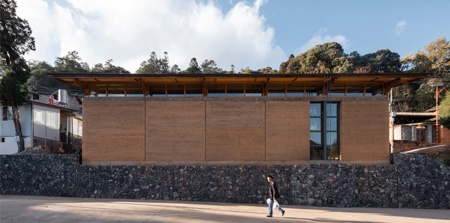

Community Hall of Dahei New Village
One University One Village Team, The Chinese University of Hong Kong
In this area, Gongfang (community hall) is a significant public building where people hold events, ceremonies, and festivals. The original Gongfang in this village has been deemed unsafe due to uneven settlement of its foundation. Research shows that socioeconomic value is crucial in sustainable rural development. Public space such as Gongfang plays an important role in social sustainability of rural areas. After the discussion with local government officials, we decided to employ innovative rammed earth construction technology to rebuild it, for a safer and more comfortable space, anchoring to the environment and community. The reconstructed Gongfang situated on the original site after the former one was demolished. The layout and circulation are optimized based on the villagers’ lifestyle and the original functions. The structural framework consists of a reinforced concrete foundation, ground ring beam, and top ring beam, connected by the H-steel columns altogether, ensuring the seismic safety of the building. The walls are rammed with the earth excavated on the site, mixed with a certain quantity of sand, gravel, and sticky rice jam, based on the analysis of soil grain-size distribution. Without the addition of stabilizers such as cement, these walls can be fully recycled or degraded at their end-of-life stage. The laminated bamboo roof structure offers sufficient span, daylight, durability, and aesthetics. The interior space is sufficiently high and spacious to ensure comfortable indoor air quality when accommodating large groups. Through an integrated passive design incorporating natural daylighting, ventilation, and thermal mass, the building will exhibit significantly reduced energy consumption and carbon emissions throughout its operational phase. This building was constructed by a team of villagers led by Ms. Dong, who heads the 1U1V women's construction team. The villagers were trained through the learning-by-doing process. They became interested in switching back from their brick-concrete houses because their love and belonging needs, esteem needs, and self-actualization needs are also considered and valued in this process. We followed a scientific approach to innovate traditional rammed earth technology while ensuring that the techniques were simple enough for the builders to master. The strategy of "scientific method, adaptive technology" and an approach centered on "local material, local people, and local labor" are crucial for enhancing sustainability in rural areas; they provide a transformative roadmap for regional rural construction and revitalization. Instead of promoting the benefits of imported brick and concrete, we determined whether the shortfalls of traditional rammed earth technology and the fragility of village life could be addressed in situ. The implementation of this strategy was a simple step in rebuilding the lives of the people.